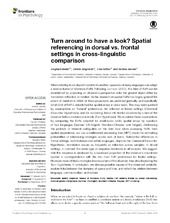| dc.contributor.author | Beller, Sieghard | |
| dc.contributor.author | Singmann, Henrik | |
| dc.contributor.author | Hüther, Lisa | |
| dc.contributor.author | Bender, Andrea | |
| dc.date.accessioned | 2016-01-29T08:43:04Z | |
| dc.date.available | 2016-01-29T08:43:04Z | |
| dc.date.issued | 2015-09-02 | |
| dc.Published | Frontiers in Psychology 2015, 6:1283 | eng |
| dc.identifier.issn | 1664-1078 | |
| dc.identifier.uri | https://hdl.handle.net/1956/11023 | |
| dc.description.abstract | When referring to an object in relation to another, speakers of many languages can adopt a relative frame of reference (FoR). Following Levinson (2003), this kind of FoR can be established by projecting an observer’s perspective onto the ground object either by translation, reflection, or rotation. So far, research on spatial FoRs has largely ignored the extent of variation in which of these projections are preferred generally, and specifically what kind of FoR is established for spatial arrays in one’s back. This may seem justified by assumptions on ‘natural’ preferences: for reflection in frontal settings (Canonical Encounter Hypothesis), and for converting dorsal into frontal situations by a turn of the observer before a reference is made (Turn Hypothesis). We scrutinize these assumptions by comparing the FoRs adopted for small-scale, static spatial arrays by speakers of four languages (German, US-English, Mandarin Chinese, and Tongan). Addressing the problem of inherent ambiguities on the item level when assessing FoRs from spatial prepositions, we use a multinomial processing tree (MPT) model for estimating probabilities of referencing strategies across sets of items. Substantial differences in frontal settings, both between and within languages, disprove the Canonical Encounter Hypothesis—translation occurs as frequently as reflection across samples. In dorsal settings, in contrast, the same type of response dominates in all samples. We suggest that this response is produced by a backward projection of the observer’s coordinate system in correspondence with the two main FoR preferences for frontal settings. However, none of these strategies involves a turn of the observer, thus also disproving the Turn Hypothesis. In conclusion, we discuss possible causes of the observed variability, explore links between the domains of space and time, and reflect the relation between language, communication, and culture. | en_US |
| dc.language.iso | eng | eng |
| dc.publisher | Frontiers | eng |
| dc.relation.uri | http://journal.frontiersin.org/article/10.3389/fpsyg.2015.01283/full | |
| dc.rights | Attribution CC BY | eng |
| dc.rights.uri | http://creativecommons.org/licenses/by/4.0 | eng |
| dc.subject | spatial cognition | eng |
| dc.subject | frames of reference (FoR) | eng |
| dc.subject | relative FoR variants | eng |
| dc.subject | frontal vs. dorsal referencing | eng |
| dc.subject | cross-linguistic comparison (German, US-English, Mandarin Chinese, Tongan) | eng |
| dc.subject | MPT modeling | eng |
| dc.title | Turn around to have a look? Spatial referencing in dorsal versus frontal settings in cross-linguistic comparison | eng |
| dc.type | Peer reviewed | |
| dc.type | Journal article | |
| dc.date.updated | 2015-12-22T10:33:15Z | |
| dc.description.version | publishedVersion | |
| dc.rights.holder | Copyright 2015 The Authors | eng |
| dc.identifier.doi | https://doi.org/10.3389/fpsyg.2015.01283 | |
| dc.identifier.cristin | 1261509 | |

